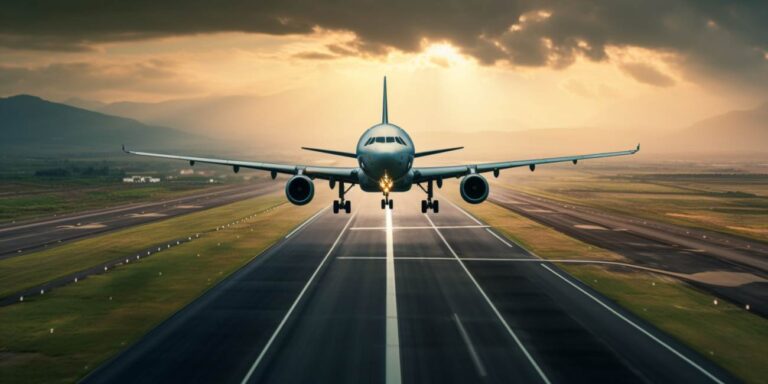In the airspace lexicon, the term heavy holds weight, both literally and figuratively. When air traffic controllers hear the word heavy, it’s their cue that a sizable beast is cruising through the skies. But, decoding this aeronautical enigma requires a dive into the intricacies of aircraft categorization.
Firstly, what does aircraft heavy mean in practical terms? The answer lies in the aircraft’s weight class. Not all planes are created equal, and the aviation world sorts them into categories based on their maximum takeoff weight. Here’s where the heavy tag comes into play.
Internationally, the classification of an aircraft as heavy is reserved for those tipping the scales at 300,000 pounds or more. It’s not merely a measure of size but an acknowledgment of the unique challenges these behemoths pose to air traffic control and the airspace they navigate.
Picture this: a colossal Boeing 747 gracefully descending towards the runway. As it approaches, the air traffic controller, armed with radar and precision, utters the word heavy. This isn’t an idle comment—it’s a signal to other aircraft in the vicinity to be aware of the significant wake turbulence trailing the heavy giant.
Wake turbulence, the invisible aftermath of an aircraft’s passage, is a formidable force. In the case of heavy aircraft, the disturbance is more pronounced, creating potential hazards for trailing planes. Hence, the heavy designation acts as a cautionary note, prompting pilots to maintain a safe distance.
Now, let’s demystify the hierarchy of aircraft categories. Beyond heavy, there are other labels such as medium and small, each denoting a specific weight range. This classification system is crucial for air traffic controllers to orchestrate a seamless flow of diverse aircraft in congested skies.
So, the next time you hear the term heavy crackling through the airwaves, envision not just a massive machine but a meticulously categorized airborne leviathan. It’s a linguistic key that unlocks a realm where size matters and where the weight of an aircraft extends beyond its physical mass, shaping the dynamics of aerial navigation.
Aircraft heavy landing procedures safety precautions
When it comes to aircraft heavy landing procedures, ensuring the safety of both passengers and crew is of utmost importance. Heavy landings occur when an aircraft touches down on the runway with a force exceeding the design limits. These incidents can result from various factors, including adverse weather conditions, mechanical failures, or errors in piloting.
Implementing effective heavy landing procedures involves a combination of pilot training, aircraft design considerations, and airport infrastructure. Pilots undergo rigorous training to handle various landing scenarios, including heavy landings. Simulator sessions are crucial in familiarizing them with the appropriate responses and decision-making processes in case of such events.
Safety precautions are integrated into every aspect of heavy landing procedures. Aircraft manufacturers design landing gear with shock absorbers and structural components capable of withstanding considerable forces. Regular maintenance checks are conducted to identify and address any potential issues with the landing gear, ensuring optimal performance during landings.
During heavy landings, air traffic control plays a critical role. Clear communication between pilots and controllers is essential for providing real-time information about runway conditions, weather updates, and any potential hazards. Air traffic controllers are trained to assist pilots during emergency situations, guiding them to a safe landing.
Runway inspections are conducted regularly to identify and address any issues that may pose a threat during heavy landings. This includes checking for debris, potholes, or any irregularities that could impact the aircraft upon landing. Additionally, airports may have designated emergency response teams on standby to quickly address any incidents.
Modern aircraft are equipped with advanced monitoring systems that record and analyze data during landings. These systems provide valuable insights into the forces experienced by the aircraft during touchdown, helping engineers and aviation authorities assess the performance of both the aircraft and the runway infrastructure.
Pilot decision-making is crucial during heavy landings. Pilots are trained to prioritize the safety of passengers and crew above all else. In the event of a heavy landing, they may choose to abort the landing and initiate a go-around procedure to reassess the situation and make a safer attempt.
Why is an aircraft heavy – extra fuel payload restrictions
An aircraft’s weight is a critical factor in its performance and efficiency. Understanding the factors contributing to an aircraft’s weight is essential for pilots, engineers, and aviation enthusiasts alike. One of the primary contributors to an aircraft’s weight is the payload, which refers to the total weight of passengers, cargo, and other items carried by the aircraft.
The amount of payload an aircraft can carry is subject to various restrictions to ensure safe and optimal operation. These restrictions are imposed to maintain the aircraft within specified weight limits, considering factors such as structural integrity, fuel efficiency, and overall performance.
Speaking of fuel, it is another significant component influencing an aircraft’s weight. Aircraft need fuel to power their engines, and the quantity of fuel they can carry is directly linked to their range and endurance. Pilots must carefully calculate the required amount of fuel for a given flight, factoring in distance, weather conditions, and alternate airport options.
The relationship between fuel and payload introduces a delicate balance. Carrying extra fuel allows for longer flights but reduces the available capacity for payload. On the other hand, prioritizing payload may limit the amount of fuel carried, affecting the aircraft’s range. This trade-off is a constant challenge for flight planners and operators.
Weight considerations become particularly critical during landing. The aircraft must meet specific weight limits to ensure a safe and controlled landing. Exceeding these limits can compromise the aircraft’s structural integrity and pose serious safety risks. Pilots adhere to strict protocols to calculate the appropriate approach speeds and touchdown weights, factoring in the aircraft’s current weight and fuel levels.
Engineers employ advanced technologies and materials to design aircraft that balance the demand for increased payload capacity with the need for fuel efficiency and safety. The constant pursuit of innovation in aviation aims to push the boundaries of what is possible, allowing aircraft to carry more payload over longer distances while maintaining optimal weight for safe landings.
Aircraft heavy classification – maximum takeoff weight limits
Aircraft heavy classification is intricately linked to the maximum takeoff weight limits, which play a pivotal role in determining the capabilities and operational scope of different aircraft. These limits, often abbreviated as MTOW, represent the maximum allowable weight at which an aircraft can safely take off. Understanding these limits is crucial for pilots, engineers, and aviation authorities to ensure safe and efficient air travel.
Aviation authorities categorize aircraft into different classes based on their maximum takeoff weight. This classification system enables a standardized approach to regulation and safety measures. The classes typically range from light aircraft with lower limits to heavy, long-haul planes with significantly higher maximum takeoff weights. Such classification facilitates streamlined regulations, as each class adheres to specific guidelines tailored to its size and capabilities.
The determination of an aircraft’s maximum takeoff weight involves various factors, including the aircraft’s structure, engine power, fuel capacity, and overall design. Engineers meticulously calculate these parameters to ensure that the aircraft can safely become airborne and maintain stable flight. The limits imposed are critical safety measures, preventing the aircraft from being overloaded and compromising its structural integrity during takeoff.
When discussing maximum takeoff weight limits, it’s essential to recognize the impact on an aircraft’s performance. Higher limits often correspond to increased payload capacity, allowing for more passengers, cargo, or fuel. This is particularly relevant in the classification of commercial airliners, where the ability to carry substantial loads over long distances is a defining characteristic.
The aviation industry uses a numerical classification system to differentiate aircraft based on their maximum takeoff weights. For instance, light aircraft may fall into the category of 0 to 12,500 pounds, while larger planes, designed for intercontinental flights, can belong to categories surpassing 800,000 pounds. This classification helps aviation professionals quickly identify an aircraft’s capabilities and limitations.
Additionally, pilots must adhere to specific procedures and guidelines related to an aircraft’s maximum takeoff weight during flight planning. The weight of the aircraft directly influences takeoff performance, including required runway length and climb rate. Exceeding the established limits can jeopardize the safety of the flight, underscoring the importance of precise calculations and adherence to weight restrictions.






